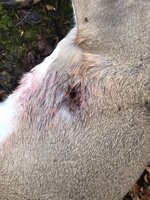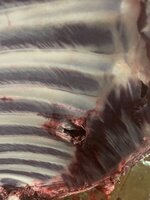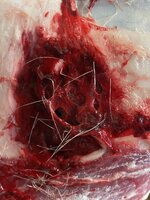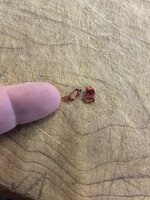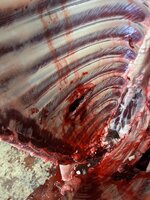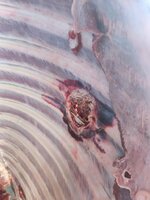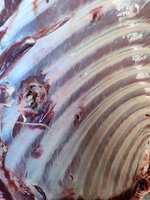Navigation
Install the app
How to install the app on iOS
Follow along with the video below to see how to install our site as a web app on your home screen.
Note: This feature may not be available in some browsers.
More options
Style variation
You are using an out of date browser. It may not display this or other websites correctly.
You should upgrade or use an alternative browser.
You should upgrade or use an alternative browser.
HAMMER Bullets Performance on Game
- Thread starter TraderMike
- Start date
Unclecroc
Lil-Rokslider
- Joined
- Jun 22, 2020
- Messages
- 184
These photos are from my buck I shot with my 6.5 creedmoor 110 hammer hunter at 3060fps. Shot was at 150 yards broadside I tucked the shoulder and he went 40 yards and crashed. You can see the petal holes in the hide around the shank, I also found two petals on the hide.
Attachments
TraderMike
WKR
- Joined
- Nov 21, 2013
- Messages
- 333
I prefer the meat-saver shot you describe as well, whenever possible. I believe most would agree shot placement is paramount, and the accuracy I have experienced with Hammers is pleasantly surprising as well, which obviously adds to ones ability to place shots in the field..My son harvested his doe with a 152 grain HH from a 30-06 going just shy of 3100 fps at the muzzle. Distance 303 yards. She jumped at impact then walked uphill 15-20 yards, then laid down, and never moved again. His shot was broadside (AKA meat saver shot) center mass. Complete pass through. Entry side shoulder meat 100% intact. Meat further back on the exit side was minimally bloodshot so we cut that out on site. Very good blood trail but this was open country and we knew exactly where she was at. Had he hit a few inches lower the blood trail wound have been profound. I separated the ribs to get the heart and the thoracic cavity was completely full of blood. I did not open the thoracic cavity to inspect the lungs.
I'm rethinking shot placement with monos. I've been shooting Barnes for 8 years. 18-19 animals thus far. With meat saver shots the animals most always run. Most in the 25-100 yard range. A few up to 25 yards. One pronghorn ran close to 200 yards with a perfect broadside side shot. We have had 2 DRT, one was meat saver shot but upper 1/3 and likely shocked the CNS, the other was a meat saver shot lower 1/3 but 3" forward towards the shoulder joint. This animal dropped on the spot and never moved.
I'm thinking of going straight up the center line of the front leg to center of mass. May lose some meat but a solid shot to the most dense part of the lungs. OR I'm thinking of going off the front line of the front leg then horizontal to the the shoulder joint. In this area lies the thoracic autonomic plexus and the great vessels.
I've also had great success with Edge TLR 175 grain. Only 3 animals, 2 DRT, one ran < 100 yards with a perfect meat saver shot and zero meat loss.
I will say Hammer bullets (152 grain HH) shoot lights out in my 30-06. Barnes 150 grain TTSX I average 0.75-1 MOA on a consistent basis at 100 yards on occasion I'll get 0.5-0.75 MOA. At 400 yards very consistently 1 MOA. Hammer held less than a 0.6" group at 424 yards. I've never grouped like that with Barnes at distance. Easiest bullet I've loaded for. I really want to love Hammer bullets but time will tell. One sample size thus far so I can't really draw any conclusions. Again with monos in general I'm going to rethink my shot placement.
I too want to love'em.... I also found load development to be very easy, and this is coming from someone who had been away from the reloading game for over 20 years.
My miniscule sample size of 2 animals taken is far from adequate to form a meaningful opinion and some of the "rumors" floating around put a seed of doubt in my mind. RS is the only hunting forum I spend time on and I typically receive honest opinions when I throw out a question like this. Thanks for your thoughts and everyone else's that has taken time to share experiences.
Unclecroc
Lil-Rokslider
- Joined
- Jun 22, 2020
- Messages
- 184
These photos are two different deer both shot with my 25-06 using a 90 grain absolute hammer at 3660fps. One was shot at 75 yards tucked tight to the shoulder and it made a massive entrance hole and the bullet and petals exited. The second was at 50 yards in the center of the ribs and it made 1” entrance and exit holes and if you look closely you can see petal holes in the ribs bullet also exited as well as petals. Both deer ran 50 yards on a death run, vitals were a bloody puddle. I am no fan boi just a fan of the results I’ve seen on paper and on game.
Attachments
Mule3006Elk
WKR
NIce. Shot placement out of curiosity for bang/flop.Just this week I shot 2 does to fill the freezer with 120 hammer hunters in 7mm-08. They are no joke with 2 bang flops. I am a hammer fan now.
TraderMike
WKR
- Joined
- Nov 21, 2013
- Messages
- 333
Mule3006Elk,
Which powder are you using for your '06?
Thanks...
Which powder are you using for your '06?
Thanks...
amassi
WKR
- Joined
- May 26, 2018
- Messages
- 4,051
This^Not hard to kill an antelope or a black bear. Both are pretty thin skinned. The only true test was the cow elk and you didn’t recover. Not a good record of success!
Sent from my SM-G991U using Tapatalk
amassi
WKR
- Joined
- May 26, 2018
- Messages
- 4,051
When you skinned it did it seem exceedingly thick or armor played to you? Or was it a bean bag full of jellyI'm not sure I would call a black bear thin skinned but I see your point.
Sent from my SM-G991U using Tapatalk
WKR
WKR
- Joined
- Jun 14, 2019
- Messages
- 2,218
Yup there was a layer of Kevlar just under the skinWhen you skinned it did it seem exceedingly thick or armor played to you? Or was it a bean bag full of jelly
Sent from my SM-G991U using Tapatalk
TraderMike
WKR
- Joined
- Nov 21, 2013
- Messages
- 333
"This" meaning what, exactly?This^
Sent from my SM-G991U using Tapatalk
I assume you are referencing NorCal's experience of not recovering a cow that was apparently struck from almost 500 yards with a less than ideal angle? And no mention of exactly where the bullet struck, because with no recovery there is no way to be certain of anything, except that the animal fell. I would be curious as to whether or not there was any blood. Was there any snow on the ground to aid in tracking, for example? Was an effort even made to follow up and recover the cow? (I assume there was though no details provided thus far.) The claim of "Not a good record of success!" seems overstated with the details given. Unless ones mind were already made up...
amassi
WKR
- Joined
- May 26, 2018
- Messages
- 4,051
Every hammer thread inevitably has antelope as some sort of evidence. They may perhaps be the easiest big game animal to kill in the lower 48. Or more locally to me guys shooting 80# blacktail forkies or Midwestern whitetails at 80 yards. Et el"This" meaning what, exactly?
I assume you are referencing NorCal's experience of not recovering a cow that was apparently struck from almost 500 yards with a less than ideal angle? And no mention of exactly where the bullet struck, because with no recovery there is no way to be certain of anything, except that the animal fell. I would be curious as to whether or not there was any blood. Was there any snow on the ground to aid in tracking, for example? Was an effort even made to follow up and recover the cow? (I assume there was though no details provided thus far.) The claim of "Not a good record of success!" seems overstated with the details given. Unless ones mind were already made up...
Sent from my SM-G991U using Tapatalk
TraderMike
WKR
- Joined
- Nov 21, 2013
- Messages
- 333
I get your point. If a bullet doesn't consistently work on elk I have no use for it, personally.
WKR
WKR
- Joined
- Jun 14, 2019
- Messages
- 2,218
Shot placement was front shoulder, which at that angle should penetrate through to the lungs."This" meaning what, exactly?
I assume you are referencing NorCal's experience of not recovering a cow that was apparently struck from almost 500 yards with a less than ideal angle? And no mention of exactly where the bullet struck, because with no recovery there is no way to be certain of anything, except that the animal fell. I would be curious as to whether or not there was any blood. Was there any snow on the ground to aid in tracking, for example? Was an effort even made to follow up and recover the cow? (I assume there was though no details provided thus far.) The claim of "Not a good record of success!" seems overstated with the details given. Unless ones mind were already made up...
There was plenty of blood where she went down, but I lost the blood after around 100 yards. It was in some extremely thick new aspen growth. I searched for 2 days until a downpour came in and I lost the sign I had and the road to get back there.
A good hound dog would have found that elk.
Mule3006Elk
WKR
150 grain: H4895Mule3006Elk,
Which powder are you using for your '06?
Thanks...
175 grain: H4831SC
Runningwater
WKR
I've been happy with hammers so far. Certainly with accuracy but only one hunt shot so far. I'd imagine like pretty much all other bullets I've used or observed others using, they each have their strong and weak points depending on the application (game, cartridge, velocity, range, etc.). I've seen most bullets fail to perform on occasion, and not always due to a desernible reason. I've seen Barnes perform perfectly and also seen them pencil though on a shoulder shot. Seen cup and cores lose their cups, seen "long range" bullets disintegrate on close range shots from hot calibers, etc. I don't think there is anything magical about hammers (or any other bullet fwiw), just an accurate, easy to reload mono alternative. I also think a lot of folks on both sides of this thread are coming to conclusions on precious little statistical evidence. I'll let folks know my experiences with hammers as I collect more. My go to will probably always be partitions for bigger "big game". Cheers and happy new year!
One was trotting away so I accidentally shot a little forward and got some shoulder and that was of course a drop and the second I was surprised I tried to shoot a little far back like lung shot with no meat damage and she dropped. Maybe one of those pedals like they are designed to do hit some cns. It made a big exit hole.NIce. Shot placement out of curiosity for bang/flop.
BAKPAKR
WKR
Does anyone know what Litz has found the ballistic coefficient to be for the 30 cal 181 HH and the 30 cal 199 HH? Anyone shot anything with the 199 HH?
amassi
WKR
- Joined
- May 26, 2018
- Messages
- 4,051
181 hh .232 g7 on applied ballistics (-.040) from "shot drops"Does anyone know what Litz has found the ballistic coefficient to be for the 30 cal 181 HH and the 30 cal 199 HH? Anyone shot anything with the 199 HH?
Sent from my SM-G991U using Tapatalk
A buck and bull shot this year with 127gr .270 Hammer Hunters each had pretty impressive exit holes. Range was 465 yds and 370 yds respectively.Is it common for Hammers to not have an exit hole? My dad tried them out this year. He shot a mule deer at about 350 yards with his 300 win mag and there was no exit. He was hesitant to use them on elk after seeing that. We did not open up the deer to see what kind of damage was done on the inside.
Similar threads
- Replies
- 21
- Views
- 1K
- Replies
- 27
- Views
- 1K
Featured Video
Latest Articles
- TT#64 Josh Boyd Elk Hunting Strategies for Every Season
- Aaron Davidson of Gunwerks
- TT#63 Dirk Durham’s Art of Elk Calling
- BIG Buck Stories with the Dirty Giants Podcast
- TT#62 Brian Barney Hunting Bulls without Calling
- Hoyt Alpha AX-2 SD Review
- Kuiu Kenai vs Outdoor Vitals Vario Hooded Jacket Review
- Hoyt RX-9 Ultra Review
- Hunting Vampire Bucks & Building an Optics Kit
- Darton Sequel ST2 35 Review

